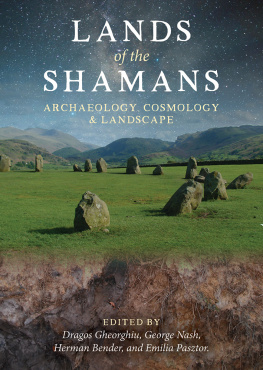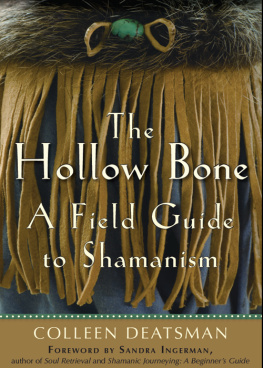
Praise for Tibetan Shamanism
A very interesting and important book by a major authority on contemporary Tibetan shamanism and on shamanism in general. He makes a contribution not just to shamanic studies, but to the preservation of the threatened spiritual heritage of the Tibetans themselves.
Michael Harner, PhD, author of The Way of the Shaman and Cave and Cosmos: Shamanic Encounters with Another Reality
Larry Peters has devoted his life to studying Nepalese shamanism as both an anthropologist and as a practitioner, and so writes with a rare combination of deep personal experience and professional expertise.
Roger Walsh MD, PhD, University of California, author of The World of Shamanism
Larry Peters has spent decades researching the healing practices in Tibetan shamanism. Tibetan Shamanism: Ecstasy and Healing is an ethnography of shamanic healing and the transmutation of soul in a Buddhist culture that ostensibly does not recognize the concept of soul.
Sandra Ingerman, MA, author of Soul Retrieval: Mending the Fragmented Self and Walking in Light
Larry Peters has an intimate knowledge of ecstatic healing methods among Tibetans and Nepalese, and his book shows how close he is to the shamans, and that he has an understanding of their reality made possible by extended field stays. I met many of the people Peters writes about during my stay in Nepal in 1970-71 and meeting them again in Tibetan Shamanism is a most welcome experience.
Per-Arne Berglie, PhD, professor emeritus, History of Religions, Stockholm University
Ive known Dr. Larry Peterss deep work on the shamanic healing practices of the Tibetan peoples for two decades. Professor Peterss experiential knowledge of this healing tradition makes this book a must read for anyone interested in Tibetan shamanism or shamanism in general.
Bhola Banstola, Nepalese Shaman, president and founder of Nepal Shaman
TIBETAN
SHAMANISM
ECSTASY and HEALING
LARRY PETERS, PhD

North Atlantic Books
Berkeley, California
Copyright 2016 by Larry Peters. All rights reserved. No portion of this book, except for brief review, may be reproduced, stored in a retrieval system, or transmitted in any form or by any meanselectronic, mechanical, photocopying, recording, or otherwisewithout the written permission of the publisher. For information contact North Atlantic Books.
Published by
North Atlantic Books
Berkeley, California
Cover photo by Larry Peters, PhD
Cover design by Daniel Tesser
Tradition, Practice, and Trance was originally published as Tradition, Practice and Trance of the Foundations Tibetan Living Treasures, in Shamanism Annual, Issue 22, December 2009. Soul in Contemporary Tibetan Shamanism was originally published in Shamanism Annual, Issue 23, December 2012. Shaman as Psychopomp was originally published in Shamanism Annual, Issue 23, December 2010. The Tibetan Healing Rituals of Dorje Ydronma was originally published in Shamans Drum, Number 45, 1997. The Yeti: Spirit of Himalayan Forest Shamans was originally published in Shamanism, Vol. 18, 2005. The Ghe-wa (Tibetan Death Rite) for Pau Karma Wangchuk Namgyal was originally published in Shamanism Annual, Issue 21, December 2008. All used by permission.
Tibetan Shamanism: Ecstasy and Healing is sponsored and published by the Society for the Study of Native Arts and Sciences (dba North Atlantic Books), an educational nonprofit based in Berkeley, California, that collaborates with partners to develop cross-cultural perspectives, nurture holistic views of art, science, the humanities, and healing, and seed personal and global transformation by publishing work on the relationship of body, spirit, and nature.
North Atlantic Books publications are available through most bookstores. For further information, visit our website at www.northatlanticbooks.com or call 800-733-3000.
Library of Congress Cataloging-in-Publication Data
Names: Peters, Larry, author.
Title: Tibetan Shamanism : ecstasy and healing / Larry Peters.
Description: Berkeley, California : North Atlantic Books, 2016.
Identifiers: LCCN 2015038279 | ISBN 9781623170301 (pbk.) | ISBN 9781623170318 (ebook)
Subjects: LCSH: ShamanismTibet Region. | ShamanismNepal.
Classification: LCC BL2370.S5 P48 2016 | DDC 299.5/4dc23 LC record available at http://lccn.loc.gov/2015038279
TABLE OF CONTENTS

Great Stupa. Photo by Larry Peters.
Soul (la) fulfills an important role in Tibetan shamanism. Tibetan beliefs regarding the individuals soul (or souls) have changed over the millennia. Before Buddhism, in indigenous shamanism (Bn), there was a belief in an immortal soul. When Buddhism came to Tibet in the mid-eighth century CE, it arrived with very different ideas regarding the soul. Buddhism rejects the existence of a soul. Still, in the folk religion of lay culture and in shamanism, the belief in soul persists, albeit how it is viewed has changed due to Buddhism and, a millennium later, due to exile and subsequent acculturation in Nepal.
This book is the result of ethnographic fieldwork that began in 1996 and continued until 2012 when the last of the four Tibetan shamans who are the subjects of this study passed away. I visited the shamans regularly during this sixteen-year period. We became friends and I was privileged to know their families, to observe their healing practices, daily life, and community events, and to be taught their belief system.
As part of my touring business, I would routinely bring students and colleagues to Nepal to study shamanism, and spend two weeks to a month doing field research prior to their arrival and after they left Nepal. These trips averaged three per year. Thus this book is more than a philosophical study of soul. It is a study of soul in the context of shamanic healing, trance states, and the interactive relationship with spirits. In other words, a map of the shamanic spiritual world is described, as are the states of consciousness and the techniques of ecstasy necessary to access it.
Research was conducted at two field sites. One is in the town of Boudhanath (Nepali for Lord of Wisdom), about 6 km from Kathmandu, the capital of Nepal, and the location of the Tibetan ), an ancient place of pilgrimage, a large reliquary structure for the Buddhist saint Mahakasyapa, and a Nepal heritage site. Boudhanath has a population of about 100,000 and is the home of a dozen or so Buddhist monasteries. The second is the Tibetan refugee camp known as Tashi Palkhiel with a population of about 1,200, located outside Pokhara, Nepals second-largest city, and about 200 km from Kathmandu. At the first site I studied the healing system of Lhamo Dolkar (in this context, lhamo means shaman goddess), and at the second, the three male shamans (lhapa or pau) who lived with their families at Tashi Palkhiel and worked as shamans.
Lhamo Dolkar and Wangchuk, the elder of the three Pokhara shamans, as discussed in this book, were both certified as authentic shaman healers by His Holiness the Dalai Lama. This is of interest in its own right as, prior to exile and the Chinese invasion of Tibet in the 1950s, shamanism was viewed as an apostate religion and its practice suppressed. The enmity toward and violent treatment of shamans by Buddhist lama has a long history in Tibet and neighboring Mongolia. At one point, shamans were burned at the stake (Kingsley 2010).












